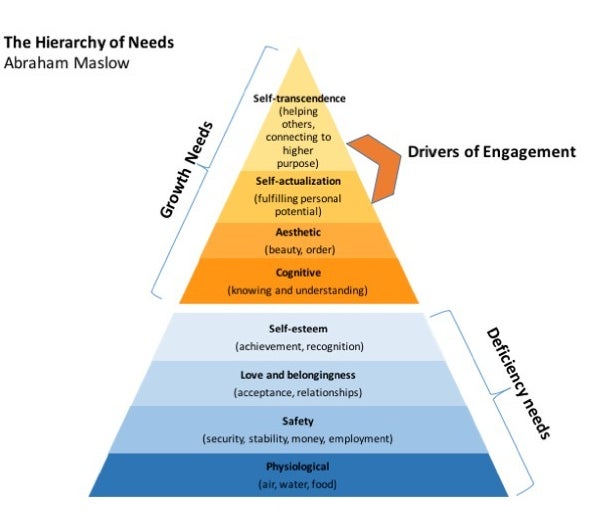
We all are well aware of “The Hierarchy of Needs” by Abraham Maslow in the world of HR and beyond. It explains the path of human motivation and is widely used to explain the human drivers when we speak about employee engagement and motivation. Maslow talks about goals being the centering principle in his motivational theory. In other words, our life goals are formed based on the hierarchy of needs.
If you are interested in getting to the root cause of the never ending employee engagement problem and never working development plans, let’s come back to the basics outlined by the science more that 50 years ago and further developed over the past decades. I am well aware that what science says is often ignored by the “real world” we live in, because we are all busy working on meeting our very important earthy goals that matter. However, employee engagement has been a puzzle for HR and managers over many years, and I believe that getting a better understanding of the famous “Hierarchy of Needs” can help organizations fix this problem.
This hierarchy of needs has two distinct sections - the “deficiency needs” and the “growth needs”:
- The “deficiency needs” are basic; they provide for physiological necessities (such as air, water, food), the need for safety (security, stability, money, employment), the need for love and belongingness (to be close to and be accepted by others); self-esteem (the need for achievement and recognition). Here we take action from the sense of deficiency (i.e. must find food, must find shelter, must find friends…). The deficiency needs must be fulfilled before the person can reach greater levels of satisfaction through pursuing the growth needs.
- The “growth needs” are cognitive (knowing and understanding); aesthetic (expression of beauty, order); self-actualization (fulfilling personal potential through expression of unique talents); self-transcendence (being at service to others, helping others realize their potential, connecting to something higher that ourselves (higher purpose, Universe, Source, God…), the unity of all being). Self-transcendence is what gives the feeling of intense fulfillment and happiness as one lives life with purpose on this planet.
I often asked myself why throughout my career I have rarely seen the hierarchy of needs being presented as the deficiency and growth needs, and why I have never seen self-transcendence as the top of Maslow's pyramid in any HR materials, trainings or presentations. Is it ignored because it speaks about each one of us having our own calling in life that we are uniquely suited to pursue and express by being ourselves and by being of the service to others, and by doing so we discover fulfillment in life? Is it because of the spiritual element in it that many may not be comfortable with? Or is it because recognizing, growing and harnessing unique strengths and talents is so hard to fit into our well-established processes where people are constantly evaluated against certain yet ever changing sets of competencies? And why do we seem to ignore the growth needs when it comes to goal-setting or development plans?
Whatever the reason is, self-actualization and self-transcendence are the two goals that give employees the feeling of being engaged in what they do, the feeling of being happy at work. Deep inside ourselves we have two inner goals – the desire to grow and the desire to contribute. We realize ourselves through our unique talents, which we express in our unique way by serving others. Disengagement happens when the growth needs aren’t met or are ignored.

Now, bringing it to the corporate world, we all know that people are looking for meaningful careers and growth when they join organizations or change jobs. We can also assume that the deficiency goals are met for people working in the corporate world (they are not starving and not living in the streets, and companies offer fair pay). Therefore, focusing on growth needs of the employees is where HR and managers can add value and make the impact, contributing to much higher levels of employee engagement.
Needs become our goals, according to A. Maslow. Human-being without goals is like a ship put onto water without a captain and without a destination – the ship will probably crush and sink somewhere in the waters and will never arrive to any destination if it manages to leave the harbor at all.
When it comes to goals, we have been widely using the SMART approach to goal setting, and one can say that the growth needs have been covered by the talent management and development plans. However, I have yet to see a company where traditional development plans truly work on the basis of the growth needs outlined by A. Maslow. The development plans that I have observed over the years largely focus on the deficiency goals – daily tasks and objectives which once achieved will result in more money (safety) and eventually a different title (self-worth, self-esteem).
Consequently, I would like to invite you to move the SMART approach to setting goals and development plans to the bottom of your preferred processes list as in reality it vastly focuses on either feeding already met deficiency needs or on simple daily actions enabling you to achieve objectives that will result in fair pay.
Instead, I suggest that you consider the approach that works successfully around the world for people who fulfill their personal and professional dreams and for organizations that have achieved and maintain incredibly high engagement levels. This approach looks at the goal-setting and development plans with the Maslow’s growth needs in mind, based on the two most important human needs – the desire to grow and the desire to contribute. It can be used for individuals, teams, organizations. It suggests that you ask your employees about the experiences that they want to have, how they want to grow personally (including the skills that they want to develop), and contributions that they want to make to the organization and to the world. Assuming that the organization offers fair pay, these goals – experience, growth, contribution - become the drivers, motivators, goals that give people incredible energy to wake up every day knowing that they live on purpose, and you will see them taking consistent daily actions towards the realization of these goals. This approach also brings the conversation with the employees to a different level, allowing your employees to express their desires and be heard, and enabling you as a manager to understand their desires beyond the deficiency needs and consequently support your employees in achieving their aspirations.
Try it for yourself, ask your employees about experiences, personal growth and contributions that they want to see for themselves in their jobs and their lives (reminder: titles and money are the deficiency needs), and then listen to what they say - you will immediately see the spark of motivation in their eyes. This process will also give you an understanding about what really matters to your employees and will give you many ideas about how you as a manager can support your employees’ growth in addition to achieving their daily business objectives.
Self-actualization and self-transcendence are the two goals that give employees the feeling of being engaged in what they do, the feeling of being happy at work. We have known this for more than 50 years. So, is it time to take it seriously and start focusing on what the science has been telling us all these years?
If you enjoyed this article and are interested in exploring unconventional ideas about the beautiful world of HR and management, you are welcome to join the newly created “Extraordinary HR” group on LinkedIn.
